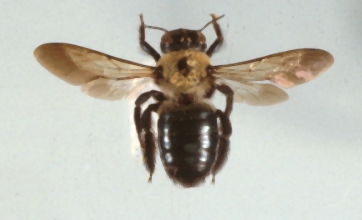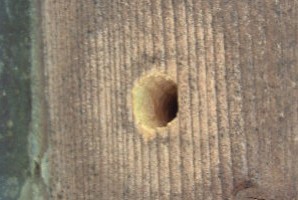Carpenter Bees
 Scientific Name
Scientific Name
Xylocopa sp.
Habitat
Carpenter bees cause damage to wooden structures by boring into timbers and siding to prepare nests. Carpenter bee nests weaken structural wood and leave unsightly holes and stains on building surfaces. Sound, undecayed wood without paint or bark is usually selected for nests; carpenter bees frequently attack dead wood on trees or lumber from southern yellow pine, white pine, California redwood, cedar, Douglas fir, cypress, mimosa, mulberry, ash, and pecan trees. They avoid most harder woods. The presence of carpenter bees around buildings and wooden structures can be annoying or even frightening; however, males cannot sting and females rarely attack. Carpenter bees are generally considered beneficial insects because they help pollinate various crop and noncrop plants.
Life Cycle
 Adults overwinter in nest tunnels in wood. They emerge in the spring, usually in late
April or early May, and mating occurs within a few weeks. The newly fertilized female
establishes a nest by burrowing into wood at right angles to the grain for about an
inch. The tunnel has clean-cut, sharp edges and is 3/8 to 1/2 inch wide. The entrance
and tunnels may appear like they were made with a brace and bit. The female then makes
a 90 degree turn and burrows with the grain, usually for 4 to 6 inches. When the nest
is completed, she places a mixture of nectar and pollen at the end and lays an egg
on it. This will be the food supply for the developing larva. She then seals off the
cell with a partition of chewed wood pulp. This process is repeated until 6 or 8 cells
have been formed. The female may build a new nest by extending an old nest, and galleries
up to 10 feet long have been formed in some cases. Larval development takes 5 or 6
weeks and new adults emerge during the summer and fall. These new adults store pollen
in preparation for hibernation but do not mate and do little if any nest building.
Carpenter bees frequently return to the nesting site(s) during following years.
Adults overwinter in nest tunnels in wood. They emerge in the spring, usually in late
April or early May, and mating occurs within a few weeks. The newly fertilized female
establishes a nest by burrowing into wood at right angles to the grain for about an
inch. The tunnel has clean-cut, sharp edges and is 3/8 to 1/2 inch wide. The entrance
and tunnels may appear like they were made with a brace and bit. The female then makes
a 90 degree turn and burrows with the grain, usually for 4 to 6 inches. When the nest
is completed, she places a mixture of nectar and pollen at the end and lays an egg
on it. This will be the food supply for the developing larva. She then seals off the
cell with a partition of chewed wood pulp. This process is repeated until 6 or 8 cells
have been formed. The female may build a new nest by extending an old nest, and galleries
up to 10 feet long have been formed in some cases. Larval development takes 5 or 6
weeks and new adults emerge during the summer and fall. These new adults store pollen
in preparation for hibernation but do not mate and do little if any nest building.
Carpenter bees frequently return to the nesting site(s) during following years.
Description
Carpenter bees are large, black and yellow insects about 1 inch long. They resemble bumble bees but the abdomen (rear end) is black and shiny and does not have the extensive yellow hairs found on bumble bee abdomens. The females can sting but rarely do so unless molested. The males cannot sting. Males have a yellow face while females have a black face.
Control
Please contact your local county extension office for current information.
